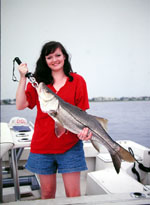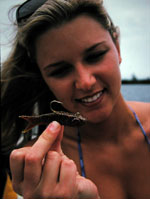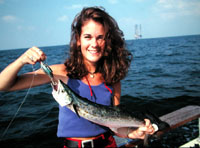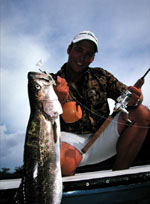
|
Features
|
|
|
|
Books
|
|
|
|
Fun & Games
|
|
|
|
Contact Us
|
|
|
John's Journal... Entry 157, Day 1
ENDLESS INSHORE FISHING
Fishing St. Lucie in January and February
 EDITOR'S
NOTE: Captain Ed Zyak of Jensen Beach, Florida,
chose the St. Lucie Estuary on central Florida's Atlantic Coast to set
up his Local Color Guide Service for two reasons. One, he's lived and
fished in this region all his life. Two, he can produce speckled trout,
redfish, flounder, tarpon and snook year-round. This area homes a phenomenal
fishery, and if you like variety, you must consider fishing there. But
rather than tell you about my experience fishing the St. Lucie Estuary,
let's let Captain Zyak tell you his story.
EDITOR'S
NOTE: Captain Ed Zyak of Jensen Beach, Florida,
chose the St. Lucie Estuary on central Florida's Atlantic Coast to set
up his Local Color Guide Service for two reasons. One, he's lived and
fished in this region all his life. Two, he can produce speckled trout,
redfish, flounder, tarpon and snook year-round. This area homes a phenomenal
fishery, and if you like variety, you must consider fishing there. But
rather than tell you about my experience fishing the St. Lucie Estuary,
let's let Captain Zyak tell you his story.
QUESTION: What makes the St. Lucie Estuary such a productive,
year-round fishing site?
ANSWER: This region is a great place to fish because we have so many options
here. We can fish during all 12 months in relatively good weather, and
this area always offers a hot species to target at any time of the year.
You may get burned-out if you fish for spotted seatrout (specks) all 12
months. However, here when you get tired of seatrout, you can catch snook,
tarpon, redfish, flounder, Spanish mackerel, king mackerel and many other
kinds of fish.
 QUESTION:
Tell me about fishing in central Florida during January and February.
QUESTION:
Tell me about fishing in central Florida during January and February.
ANSWER: During these two months, we will have a series of cold fronts
that blow through the area. The weather is changing and often is unpredictable.
You can go to bed in 80-degree weather and wake up the next morning in
30-degree weather. Then, two days later, the temperature may rise to 80
degrees again. Because of this wide variation in temperature, the fish
are always moving and changing during these two months. So at this time
of the year, I generally target snook in the estuaries. If a cold front
hits, the snook will move out of the estuaries and into the deeper, warmer
water. Depending on how fast the front moves, the snook usually will be
somewhere between the estuaries and the deep holes. Or, if our region
has an extended cold front, the snook will be holding in the deep holes.
These fish are very sensitive to temperature and can't tolerate water
that's colder than 60 degrees. During January and February, I'll use a
deep-water jigging technique to catch snook. I usually will fish with
a 3/8-ounce, root-beer-colored DOA Terror Eyz jig. Not only will I vertically
jig this soft-plastic lure, I'll use my Minn Kota trolling motor to move
the boat to the holes and cast and retrieve the Terror Eyz close to the
bottom. The snook and the redfish usually will hold on the bottoms of
these holes. However, if you swim the Terror Eyz in the mid-water range
in these holes, you also can catch tarpon -- a species that we catch every
month of the year. We have a resident tarpon population. Any day you fish
-- regardless of the species you fish for -- you'll most likely catch
a tarpon. I often catch tarpon in the same holes that I fish for snook.
 QUESTION:
What other species can you catch during January and February?
QUESTION:
What other species can you catch during January and February?
ANSWER: We still take plenty of speckled trout then. The trout usually
will hold in deep water early in the morning. By noon to 2:00 p.m., the
fish will move up in 1 or 2 feet of water, and you can catch the trout
by sight fishing. On a bright, clear, warm afternoon in January and February,
I've often seen trout in 1 foot or less of water. The dark bottoms usually
warm-up quicker than the sandy bottoms do, so I'll look for trout on muddy
bottoms in the afternoon. I'll stand on the poling platform on the back
of my boat, but instead of poling, I'll use my trolling motor to maneuver
my fishermen to within casting distance of those trout.
 QUESTION:
What else can you catch in January and February?
QUESTION:
What else can you catch in January and February?
ANSWER: We also catch pompano and Spanish mackerel during these two months
because they move inshore at this time of the year. We have an area down
here where the Spanish mackerel really move in good, and you can catch
these fish until your arms get tired. Casting Terror Eyz jigs and any
other bait that dashes and flashes will produce Spanish mackerel. One
of the biggest advantages to catching Spanish mackerel -- or any other
fish you want to eat -- is that Mrs. Peters' SmokeHouse is in this area.
Sally Peters opened this business in 1931 and started smoking fish on
the halves. In other words, she smokes half of your catch and gives you
the other half. If you've never eaten fresh, smoked Spanish mackerel with
Sally Peters' fish dip, you just haven't lived. Sally Peters' smoked-fish
dip is famous around here. Many of the anglers who fish with me go specifically
to take fish to Sally Peters' SmokeHouse.
For more information, call Captain Ed Zyak with Local Color Guide Service at (772) 485-FISH or e-mail him at localcolorgs@aol.com. Mrs. Peters' SmokeHouse is located at 1500 North East Dixie Hwy, Jensen Beach, Florida. For more information, call (772) 334-2184. You can reach DOA Lures by calling 877-DOA-LURE or going to the Web site www.doalures.com Learn more about Minn Kota trolling motors by going to www.johnsonoutdoors.com or calling 800-227-6433.
TOMORROW: FISHING ST. LUCIE ESTUARY IN MARCH AND APRIL
Check back each day this week for more ENDLESS INSHORE FISHING ...
Day 1 - Fishing St. Lucie
in January and February
Day 2 - Fishing St. Lucie Estuary in March
and April
Day 3 - Fishing St. Lucie Estuary in May
and June
Day 4 - July and August Fishing in the Estuary
Day 5 - St. Lucie Estuary - Fishing For The
Rest Of The Year